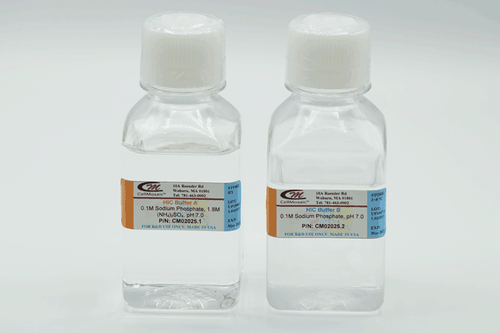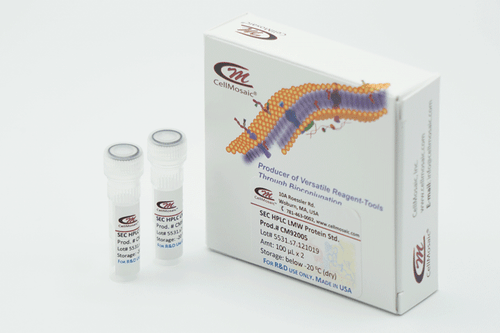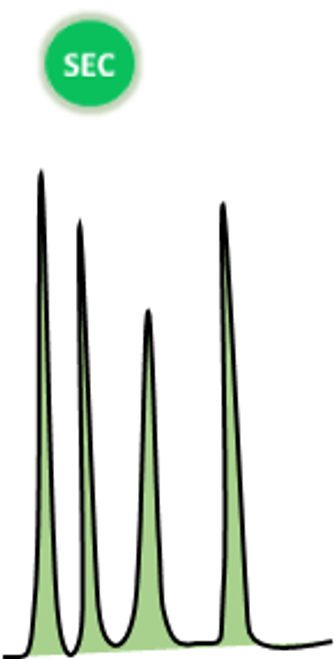Product Description
| Download Documents | |
| SDS | USER MANUAL |
CellMosaic® has designed this kit for labeling antibody (IgG) with monomethyl auristatin F (MMAF) using a maleimidocaproyl linker (Mc), which forms a stable linkage. MMAF is a new antimitotic auristatin derivative featuring a charged C-terminal phenylalanine residue. The kit includes maleimide-activated MMAF (Mc-MMAF), which can be directly coupled to the antibody following reduction and alkylation in a single step (a method developed by Seattle Genetics: Sun et al., 2005, Bioconjugate Chem. 16, 1282-1290). The product is then purified to remove any unreacted drugs.
This kit provides the materials to conjugate 1-3 mg of one (CM11422x1) or three (CM11422x3) antibody samples (IgG).
If you have a smaller amount of IgG, a non-IgG type antibody, or other customization needs, please select the customization option and/or fill out the information above.
Drug Information
- Name: Monomethyl auristatin F (MMAF) with maleimidocaproyl linker
- CAS number: 863971-19-1
- Mechanism of action: Inhibits cell division by blocking the polymerization of tubulin.
- Activities: Antioxidant, anti-inflammatory, anticancer, and insecticidal activities.
- Selected References: 1) Doronina SO, Mendelsohn BA, Bovee TD, et al. Enhanced activity of monomethylauristatin F through monoclonal antibody delivery: effects of linker technology on efficacy and toxicity. Bioconjug Chem 2006;17: 114–24. 2) Polson AG, et al. Antibody-drug conjugates for the treatment of non-Hodgkin's lymphoma: target and linker-drug selection. Cancer Res. 2009;69(6):2358−2364.
Requirement for Antibody
- Preferably >90% pure by gel electrophoresis
- Total amount: 1-3 mg protein content as measured by UV
Key Features of this PerKit™
- Simple and efficient labeling of IgG1 with MMAF, minimizing toxin exposure .
- Stable linkage.
- Delivers an average of 4 MMAF molecules per antibody.
- Fast preparation: 4 hours total, with less than 1 hour of hands-on time.
- Includes all necessary reagents and supplies for preparation and purification.
- Achieves over 95% conjugation, free from unreacted MMAF.
- Post-conjugation services available at CellMosaic for HPLC analysis and calculation of the DAR.
Conjugation Chemistry

Protocol
Schematic workflow diagram for preparing antibody-MMAF conjugates, starting with 3 mg of IgG. (Reagent volume will vary if the amount of IgG is less than 3 mg).

Other Considerations
Drug-to-Antibody Ratio (DAR) and Characterization by UV
In this kit, the target DAR is 4. Depending on your antibody, you may achieve a slightly higher or lower DAR.
Unfortunately, Mc-MMAF does not have a characteristic UV absorbance that allows for easier DAR calculation by UV. For DAR calculation and to check the homogeneity of the ADC, you can analyze it using hydrophobic interaction chromatography (HIC). If you do not have access to the necessary facilities, you can send your sample to CellMosaic for analysis.
Aggregation and Precipitation Issue for MMAF Labeling
Mc-MMAF is very hydrophobic. This kit is designed to minimize the aggregation and precipitation issues typically encountered with Mc-MMAF labeling. However, you may still notice some solid precipitate or ADC aggregation during the reaction. The precipitate will be removed during purification. Depending on the properties of your antibody, recovery may range from 40-80%.
If you are concerned about aggregation, you can use size exclusion chromatography (SEC) to assess the extent of aggregation.
If you do not have access to an HPLC facility, you can send your sample to CellMosaic for analysis.
Recommended Storage Conditions
Recommend storing at 2-8°C for short-term. Do not freeze in PBS buffer. Based on our preliminary data, the conjugate made with this kit remains stable in PBS buffer at 2-8 °C for several weeks. However, you may notice an increased amount of aggregation after some time. The stability of your conjugate may vary depending on your antibody and should be checked either by HPLC or UV.
For long-term storage, dilute your ADC in Stabilization PBS Buffer (5x) (included in this kit). Aliquot and store the conjugate in a freezer at temperatures below -20°C or lyophilize to dryness. Avoid repeated freeze-thaw cycles. If the ADC is in lyophilized powder form, once dissolved, the solution should be used within a few days.
ADC Stabilizing Buffer
CellMosaic’s proprietary ADC stabilizing PBS buffer (5x) contains 5x PBS buffer and other stabilizers designed to prevent hydrophobic drugs from interacting with each other during storage, which can lead to ADCs precipitation. The Stabilizing Buffer also helps preserve the structure of the ADCs during lyophilization. This biocompatible buffer can be used directly for both in vitro and in vivo studies. For more information on stabilization buffers, please visit our website.
Submit Samples for HPLC Analysis
If you are submitting samples to CellMosaic for SEC and HIC analysis, please follow these instructions:
- Visit CellMosaic’s HPLC analysis page, select SEC HPLC Analysis (Product# AS0023) and HIC HPLC Analysis (Product#: AS0025), choose the quantity (number of samples. Bulk discounts available for multiple samples), and submit your order. Alternatively, you can email info@cellmosaic.com for a quote and to place the order.
- Dilute your un-conjugated antibody in PBS buffer to a concentration of 1 mg/mL. Transfer 50 μL of the diluted solution into a 500 μL micro-centrifuge tube and label the vial properly.
- Transfer 50 μL of ADC (non-diluted solution) into a 500 μL micro-centrifuge tube and label the vial properly.
- Ship your samples with a cold pack for overnight delivery.
Related Products
ADC Control hIgG1-MMAF with VC-PAB-Linker (Product #: CM51101): A control ADC made with a non-binding human IgG1 subtype. This product contains an average of 4 MMAF molecules per antibody and has low endotoxin levels, making it suitable for in vitro and in vivo studies.
HRP-MMAF (1:1) Conjugate (Product #: CM53216): An assay reagent used for HRP based assay.















